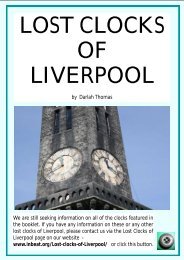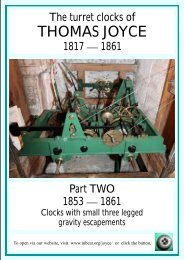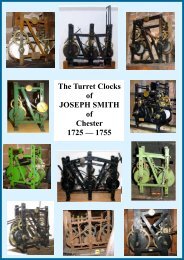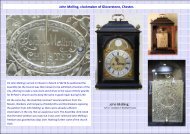Joseph Smith Clockmaker of Barthomley and Chester
Joseph Smith of Barthomley and Chester was a prolific clockmaker in the eighteenth century. Take a look at some of his clocks and read his history.
Joseph Smith of Barthomley and Chester was a prolific clockmaker in the eighteenth century. Take a look at some of his clocks and read his history.
- No tags were found...
Create successful ePaper yourself
Turn your PDF publications into a flip-book with our unique Google optimized e-Paper software.
<strong>Joseph</strong> <strong>Smith</strong> ‘s Domestic Clocks made in <strong>Chester</strong> 8<br />
<strong>Joseph</strong> <strong>Smith</strong> two train table clock with alarm <strong>and</strong> five minute repeat<br />
From the Bonhams’ catalogue ‘Fine Clocks’ auction, 11 July 2018.<br />
Lot 59 A FINE AND RARE MID 18TH CENTURY FIVE-MINUTE REPEATING MAHOG-<br />
ANY TABLE CLOCK WITH ALARM, MOON PHASE INDICATION AND EXHIBITION<br />
PROVENANCE<br />
<strong>Joseph</strong> <strong>Smith</strong>, <strong>Chester</strong>.<br />
The bold h<strong>and</strong>le over a stepped moulded caddy with gadrooned border over outset<br />
corners with reeded <strong>and</strong> carved Corinthian columns raised on carved ogee bases,<br />
each side with a hinged <strong>and</strong> lockable glazed door to access the movement, the 9.75<br />
inch arched brass dial with flowing foliate scroll engraved border framing the<br />
painted rolling moonphase, the rococo sp<strong>and</strong>rels enclosing the silvered Roman <strong>and</strong><br />
Arabic chapter ring with finely matted centre with alarm setting disc <strong>and</strong> chamfered<br />
date aperture, signed ‘Jos: <strong>Smith</strong>, CHESTER’ between V <strong>and</strong> VII, a lever visible in the<br />
mask by IX which sets the alarm (<strong>and</strong> in doing so, silences the hourly strike), the<br />
twin gut fusee movement with five turned finned pillars screwed through the backplate<br />
<strong>and</strong> pinned to the front, now converted to anchor escapement, with<br />
countwheel strike acting on a single bell, the alarm <strong>and</strong> repeat using three further<br />
hammers <strong>and</strong> two smaller bells, 58cms (23ins) high.<br />
Exhibited: ‘Time & Place: English Country Clocks, 1600-1840’, an exhibition by The<br />
Antiquarian Horological Society at The Museum <strong>of</strong> the History <strong>of</strong> Science, University<br />
<strong>of</strong> Oxford, 25 November 2006 - 15 April 2007. Exhibit number 43.<br />
This imposing <strong>and</strong> innovative provincial clock was one <strong>of</strong> 68 exhibits selected to<br />
show the best <strong>of</strong> provincial horology over nearly two <strong>and</strong> a half centuries. Illustrated<br />
over four pages, the clock is described in the exhibition catalogue. The alarm<br />
does not have a separate power source <strong>and</strong> so when it sounds, it strikes the number<br />
<strong>of</strong> ‘lost hours’ i.e., those that would have struck since the alarm was set. This action<br />
ingeniously brings the countwheel back into synchronization. Quarter repeating<br />
clocks were not uncommon in the mid 18th century, but five-minute repeating examples<br />
are extremely rare.










